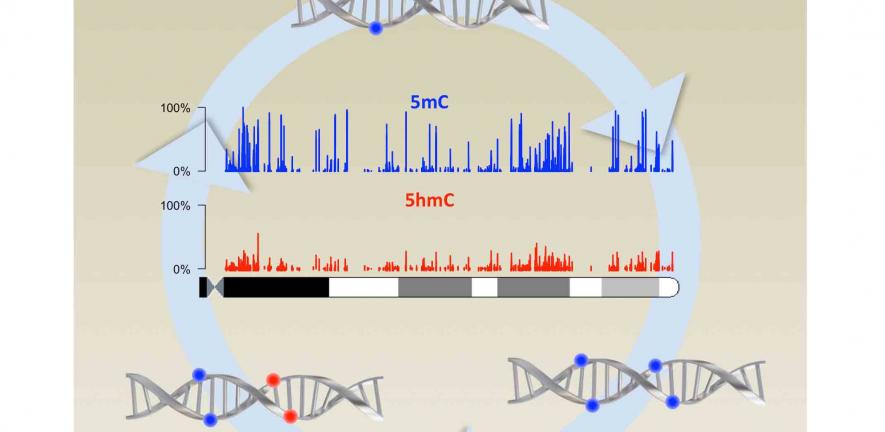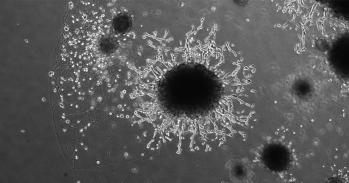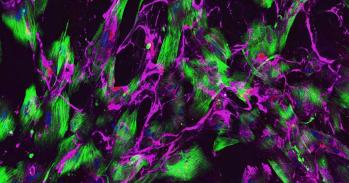
New technique has important implications for stem cell research and the development of regenerative medicines.
New technique has important implications for stem cell research and the development of regenerative medicines.
Sequencing DNA is becoming an increasingly important part of science and medicine and we are pleased to have met the challenge of finding a way to sequence this important new base modification.
Professor Shankar Balasubramanian FRS, of the University of Cambridge Chemistry Department and Cancer Research UK Cambridge Research Institute
Collaboration between scientists at Cambridge University and the Babraham Institute has demonstrated a new technique that will significantly improve scientists’ ability to perform epigenetics research and help unlock the door to understanding how cells develop and function. Epigenetics is a branch of genetics that studies modifications to the DNA which affect gene activity. The research, published today (26 April) in the journal Science, has important implications for stem cell research and the development of regenerative medicines.
All the cells in the body have the same DNA sequence (genome), but it is how this DNA sequence is interpreted that results in the formation of different cell types. Epigenetic changes control how a DNA sequence is interpreted, specifically how different genes are switched on and off in different cell types, tissues and organs.
One of the most studied epigenetic marks is the addition of a very small chemical modification called a methyl group to DNA, which turns associated genes off. Methyl groups are always added to the DNA base cytosine and so this chemical modification is called 5-methylcytosine (5mC). Babraham Institute scientists are involved in researching the role of another DNA chemical modification in mammals called 5-hydroxymethyl-cytosine (5hmC), which is believed to be important for stem cell function, helping to define how the body develops. 5hmC may be a separate epigenetic mark or possibly be part of the process which removes methyl groups from DNA, allowing genes to be switched on again. Decoding the ‘epigenome’ will provide greater understanding of how cells are regulated and has major implications for regenerative medicine and how cells such as stem cells can be controlled.
Professor Shankar Balasubramanian FRS, of the University of Cambridge Chemistry Department and Cancer Research UK Cambridge Research Institute, and his PhD student Michael Booth invented new chemistry to allow the recently discovered base 5hmC to be sequenced in DNA at single base resolution. This was not possible using existing methods. In a fruitful collaboration between the Cambridge group (led by Balasubramanian) and the Babraham Institute (led by Professor Wolf Reik FRS), this method was applied to sequence 5hmC and 5mC in embryonic stem cell genomic DNA.
Balasubramanian, whose group previously co-invented Solexa sequencing, explained, “Sequencing DNA is becoming an increasingly important part of science and medicine and we are pleased to have met the challenge of finding a way to sequence this important new base modification.”
Michael Booth, co-inventor of the technique, said, “We developed a chemistry that was specific for this new modified DNA base, 5hmC. This allowed us to accurately distinguish between 5mC and 5hmC at single base resolution in the genome.”
Dr Miguel Branco from the Babraham Institute who is joint lead author commented, “There was a real need in the field for a technique that would map both 5hmC and 5mC in the genome quantitatively and at high resolution. We applied this new technology to embryonic stem cells and immediately recognised its power in furthering our understanding of the biological functions of these DNA modifications.”
Professor Wolf Reik who led the study at the Babraham Institute, which receives strategic funding from the Biological Sciences Research Council (BBSRC) said, “It has recently become apparent that in addition to DNA methylation, there are other modifications of DNA, such as for example hydroxymethylation. This suggests that DNA modifications are more dynamic than we previously thought. With the new method we are now in a position to map these modifications at great precision, and to relate them to stem cell function, ageing, and perhaps more generally to how the environment interacts with the genome.”
The Babraham Institute undertakes world-leading life sciences research to generate new knowledge of biological mechanisms underpinning ageing, development and the maintenance of health. Professor Michael Wakelam, Director of the Babraham Institute, said, “This is an excellent example of collaboration between research institute and University research scientists. The work will improve our knowledge of how cells develop, with potential long-term benefits to society.” In addition to the BBSRC, this research was supported by the MRC, the Wellcome Trust and the EU.
Professor Daan Frenkel ForMemRS, Head of the Department of Chemistry at the University of Cambridge, commented, “This new technique, which reflects the continued innovative work of Professor Balasubramanian and his team, will dramatically change how epigenetic research is conducted. By collaborating with experts at Babraham, they have also demonstrated how the technique will have significant implications for regenerative medicine.”
This work is licensed under a Creative Commons Licence. If you use this content on your site please link back to this page.





